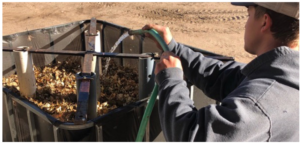As Reported: By Kansas Living: It’s commonly said farmers are the original environmentalists. Through years of trial, error, research and knowledge, farmers are adapting to the world around them. A farmer’s best ally is the ground they till, so taking care of that ally is in their best interest. With increased knowledge comes changed perspectives and enhanced practices. Regenerative agriculture is one new way farmers are evolving.
The definition of regenerative agriculture can vary depending on the farmer and can often get confused with sustainable farming practices.
 Cameron and Connor Peirce, father and son in Reno County, are implementing regenerative practices on their land and define the two techniques separately.
Cameron and Connor Peirce, father and son in Reno County, are implementing regenerative practices on their land and define the two techniques separately.
“Sustainable agriculture often just maintains the current practices and the current state of the land, whether that land is already degraded or if it’s productive,” Connor says. “Regenerative agriculture is based on its root word, regenerate. You would be improving on what is already there. Improving the soil, improving practices and improving what you are doing to manage the land.”
Regenerative agriculture might be a new concept for some, but its practices have been around for generations. On the Peirce farm, they can trace the use of cover crops back to the 1930s and 40s, prior to commercial fertilizer; and Cameron has been utilizing no-till on his acres since the 1990s. No-till is a practice farmers use to decrease the amount of soil erosion that is caused by tillage.
Common regenerative practices include cover crops, no-tilling, rotating crops grown in the same field, grazing livestock on cover crops and composting.
Another Reno County farmer, Austin Schweizer, has incorporated cattle into his regenerative agriculture practices to add one more level of improvement to his crop soil.
“I originally started no-tilling and I thought that was the answer,” Schweizer says. “Then I learned about cover crops and how well they work along with no-till. Then I started looking at regenerative agriculture and discovered experts suggest grazing the cover crops with cows. It all works together in a system.”
FIRST INTRODUCTIONS
Schweizer first heard about regenerative agriculture from a guest speaker, Jim Ball, in his soil health class at Hutchinson Community College. He didn’t understand all of the concepts Ball spoke about at first, but later, when attending the Soil Health U Conference held by the High Plains Journal, he ended up sitting right next to Ball and started a conversation and
mentorship that is still active today.
Schweizer was not the only farmer who discovered regenerative agriculture through classes and conferences. Levi Prieb, farmer in Reno County, also discovered the new farming principles through Hutchinson Community College.
“I had a teacher there, Steve Sears, who first started showing us and talking about cover crops and no-till,” Prieb says. “It was something I hadn’t been exposed to much growing up while doing conventional farming practices, and at the time, I didn’t see any need to change. I realized there was something different out there, different options to grow different crops.”
Prieb is currently reducing his use of chemicals and increasing cover crop acreage. He is new to regenerative agriculture, planting his first cover crop acres in 2018. He had success with his first experiment and is trying different blends of species to figure out what is best for his farm ground and crop rotation.
Prieb, Schweizer and the Peirces all have similar advice to anyone who is interested in starting regenerative practices on their own operations:
Start small and be patient. Results will not happen overnight, and measuring success depends on what you are hoping to improve.
“You don’t see results right away,” Cameron says. “It takes a couple of years of getting your soil into shape, but there are times when you do see results within a year and it’s pretty exciting. We do some side-by-side comparisons with conventional and regenerative fields and we try to make it so we can see a difference to make sure what we are doing is actually beneficial.”
MEASURING SUCCESS
One measure of success Schweizer does each year is look at the biological activity and carbon and nitrogen levels
in his soil.
“Say you grew a cover crop, then killed it and planted your cash crop in the same field,” Schweizer says. “Now every time it rains, that cover crop is going to break down and feed the microbes which are going to cycle nutrients to feed your growing cash crop and its roots.”
Another measure of success can come from soil tests that look at the microbial activity. One of Connor’s goals is to increase the fungal populations in the soil. Most soils have a ratio of 10-to-one bacteria to fungi. He hopes to get their soil to a one-to-one ratio by creating bioreactors that will compost materials into microbially diverse, fungal-dominant product.
Fungi break down the organic material in the soil and cycle nutrients to the roots/soil. The bioreactor starts the breakdown process of the organic matter and once it’s added to crop soil, it adds more fungi counts to counterbalance the ratio of 10 to one, to make it more equal ratio of bacteria to fungi. This process takes about a year to transform chopped straw, alfalfa and native soil into a form that can be incorporated during their seeding operations.
The benefits of the bioreactor include increasing crop yields, soil nutrient availability, soil carbon sequestration and soil water-retention capacity.
MULTITUDE OF BENEFITS
Farmers are dedicated to using chemicals like fertilizer and pesticides responsibly. These products can be costly, so it makes sense they use them sparingly. For farmers who utilize regenerative agriculture practices, that aspect is appealing to them.
Regenerative agriculture allows farmers to use less chemicals, which saves them money and increases the use of naturally occurring nutrients.
Both Schweizer and the Peirces understand the economic and environmental benefits of regenerative agriculture practices.
“I think consumers will like the soil benefits and the crop health benefits of using fewer fertilizers and herbicides,” Schweizer says.
The Peirce family also hopes to use fewer chemicals in the future and potentially phase them out altogether.
Prieb believes consumers care about what they eat and want to make the right choice of food for themselves and their families. In addition to taking care of the soil, regenerative practices promote water retention to prevent erosion and runoff. Prieb hopes his regenerative agriculture practices will have better water use and retention in harsh weather cycles.
“Our rainfall has been sporadic this year,” Prieb says. “I’m trying to grow cover crops to help retain soil moisture longer to help the next cycle of crops get to the next rain.”
Schweizer has similar goals to improve water retention in his fields.
“There are times where we have needed rain to keep our crops alive and we can’t get it,” Schweizer says. “By doing the regenerative practices and working on soil health, my soils are more resilient. When we get in a stressful time, my crops have been able to take the stress longer until there is another rainfall.”
Prieb knows experience is the best teacher and if a farmer can try it out for themselves, that is the best way for them to learn how regenerative agriculture can help their operation.
Discussions around regenerative agriculture, sustainable practices and climate change are becoming top of mind for those in agriculture.
Organizations like American Farm Bureau Federation and several others are working to provide recommendations to help care for our planet. The Food and Agriculture Climate Alliance (FACA) was formed in February 2020 to encourage and incentivize farmers to reduce energy consumption and increase on-farm solutions to reduce greenhouse gases, including soil health. Read more about the alliance at www.agclimatealliance.com.
Farmers are the original environmentalists. And they’re continuing to develop practices to advance and improve their methods to care for the planet we all love.




